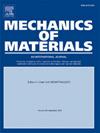Thermo-mechanical modeling and behavior analysis of titanium-matrix composites via laser powder bed fusion
IF 3.4
3区 材料科学
Q2 MATERIALS SCIENCE, MULTIDISCIPLINARY
引用次数: 0
Abstract
Laser powder bed fusion (LPBF) gives new insights into the effective fabrication of multi-material parts. However, they have not reached mechanical reliability due to undesirable physical defects such as porosity related to powder spatter. The effect of a powder bed-substrate system with such defects on the thermo-mechanical behavior of multi-material parts is still unclear. In this paper, considering porosity due to powder spatter, a multi-material property model of titanium-matrix composites (TMCs) is established based on the mixture method. Considering temperature-dependent thermal properties, an integrated thermo-mechanical modeling of TMCs is developed to predict the residual stress and deformation of the as-built parts. The three-dimensional transient thermal and stress fields are predicted using the differential quadrature method (DQM). The predicted results show excellent agreement with the predictions and experimental results in the literature. Furthermore, the effect of process parameters, ceramic, part dimension, and porosity on the thermo-mechanical responses of TMCs is analyzed. The results show that the interface between the powder bed and substrate is subjected to the highest thermal gradient and residual stress. In addition, the thermal gradient, residual stress, and interfacial deformation increase with the increased energy density, porosity, and substrate thickness. These results can provide a guide for the design and manufacturing of multi-material parts via LPBF.
激光粉末床熔接钛基复合材料的热力学建模及性能分析
激光粉末床熔合(LPBF)为多材料零件的有效制造提供了新的见解。然而,由于不希望的物理缺陷,如与粉末飞溅有关的孔隙率,它们尚未达到机械可靠性。具有此类缺陷的粉末床-衬底体系对多材料零件热力学行为的影响尚不清楚。本文考虑粉末溅落引起的孔隙率,基于混合法建立了钛基复合材料的多材料性能模型。考虑到温度相关的热性能,建立了tmc的综合热-力学模型,以预测成品零件的残余应力和变形。利用微分正交法(DQM)对三维瞬态热场和应力场进行了预测。预测结果与文献中的预测和实验结果吻合良好。分析了工艺参数、陶瓷、零件尺寸、孔隙率等因素对复合材料热力学响应的影响。结果表明:粉末层与基体之间的界面受到最大的热梯度和残余应力;此外,热梯度、残余应力和界面变形随能量密度、孔隙率和衬底厚度的增加而增加。研究结果可为LPBF多材料零件的设计和制造提供指导。
本文章由计算机程序翻译,如有差异,请以英文原文为准。
求助全文
约1分钟内获得全文
求助全文
来源期刊

Mechanics of Materials
工程技术-材料科学:综合
CiteScore
7.60
自引率
5.10%
发文量
243
审稿时长
46 days
期刊介绍:
Mechanics of Materials is a forum for original scientific research on the flow, fracture, and general constitutive behavior of geophysical, geotechnical and technological materials, with balanced coverage of advanced technological and natural materials, with balanced coverage of theoretical, experimental, and field investigations. Of special concern are macroscopic predictions based on microscopic models, identification of microscopic structures from limited overall macroscopic data, experimental and field results that lead to fundamental understanding of the behavior of materials, and coordinated experimental and analytical investigations that culminate in theories with predictive quality.
 求助内容:
求助内容: 应助结果提醒方式:
应助结果提醒方式:


